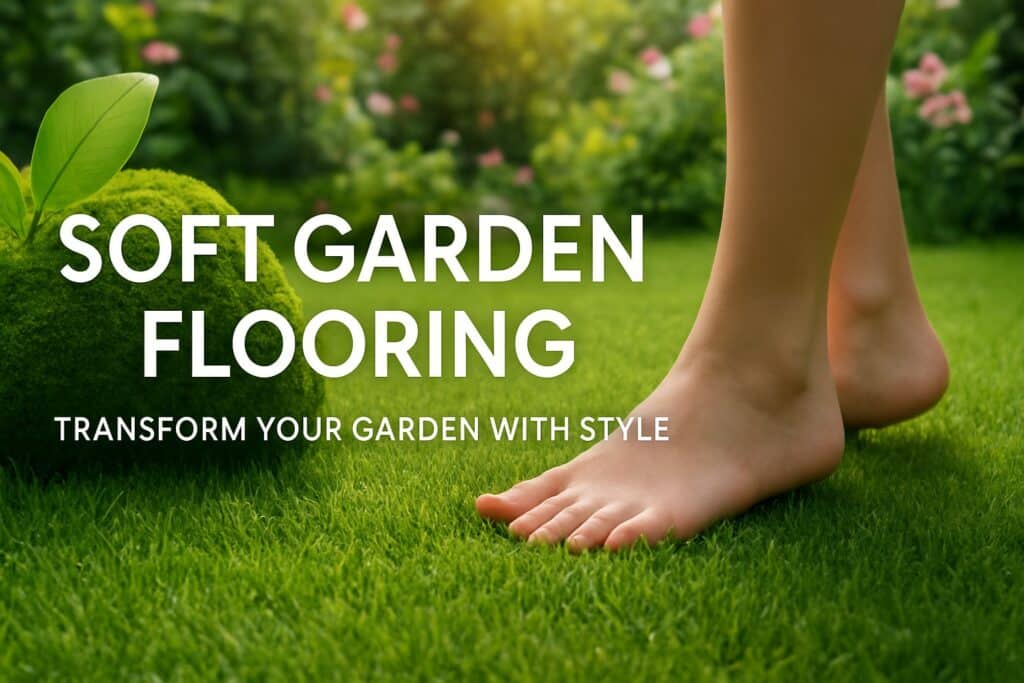Are you ready to elevate your outdoor living space in 2025? Soft garden flooring is rapidly becoming the top choice for homeowners seeking comfort, safety, and modern style in their gardens.
This article uncovers the leading trends and essential options in soft garden flooring, so you can create a beautiful, secure, and inviting environment for everyone. Explore 9 innovative flooring ideas, learn their key benefits, and gain expert tips on selection, installation, and long-term maintenance.
Discover how the right flooring can transform your garden into a sanctuary that’s both practical and visually stunning.
Why Choose Soft Garden Flooring in 2025?
Transforming your outdoor space in 2025 means prioritizing comfort, aesthetics, and sustainability. Soft garden flooring is quickly becoming the top choice for modern landscapes, offering a blend of safety, style, and practicality. Let’s explore the reasons driving this trend and how it can elevate your garden experience.
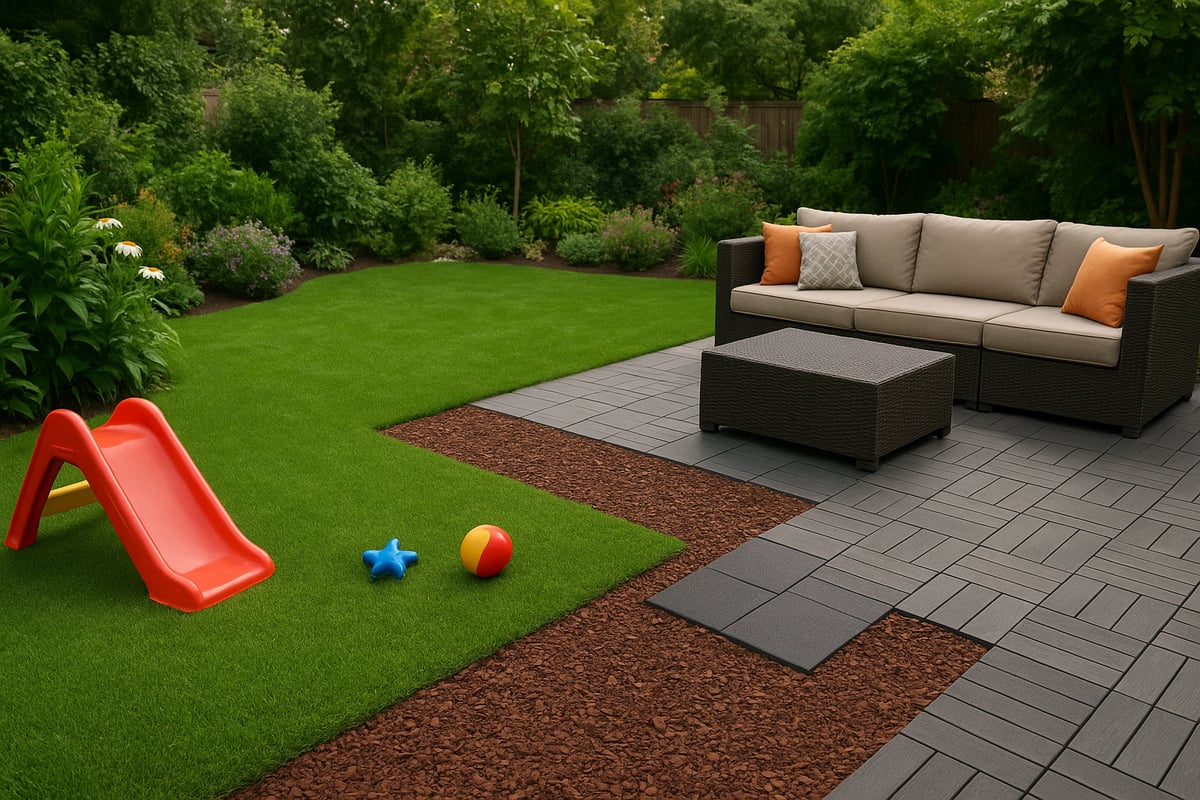
Comfort and Safety for All Ages
Soft garden flooring offers essential protection for families. Cushioned surfaces reduce the risk of slips and injuries, making outdoor areas safe for children and seniors. Materials like rubber mulch and foam tiles are designed for impact absorption, providing peace of mind during playtime or gatherings.
- Cushioned surfaces relieve strain during standing and walking.
- Popular in playgrounds for safety.
- Ideal for homes with kids or elderly residents.
Modern Aesthetics and Design Flexibility
Today’s soft garden flooring comes in a variety of textures, colors, and patterns to suit any garden theme. Whether you prefer a lush, green look or a modern, minimalist vibe, the options are vast. Urban gardens often use artificial turf for a vibrant, evergreen appearance. For more on current design trends, see 2025 Outdoor Flooring Trends.
- Mix natural and synthetic materials for a unique style.
- Wide palette for custom designs.
- Fits both small patios and large landscapes.
Sustainability and Eco-Friendly Choices
Many soft garden flooring solutions use recycled or sustainable materials, appealing to eco-conscious homeowners. Recycled rubber tiles help reduce landfill waste, while cork and other biodegradable options support green living. According to Houzz 2023, 65% of homeowners now prefer eco-friendly landscaping, making sustainable soft garden flooring a smart investment.
- Recycled materials lower environmental impact.
- Eco-friendly flooring supports biodiversity.
- Popular among green-minded consumers.
Maintenance and Durability Considerations
Soft garden flooring options typically require less upkeep than traditional hardscapes. UV-resistant and weatherproof materials ensure your space looks great year-round. Synthetic turf with built-in drainage makes cleaning easy, even after heavy rain.
- Minimal maintenance compared to stone or wood.
- Weatherproof for all seasons.
- Durable surfaces resist fading and wear.
Versatility for Different Spaces
From patios and play zones to pathways and shaded retreats, soft garden flooring adapts to every corner of your garden. Modular designs allow for easy customization and upgrades as your needs change.
- Suitable for varied outdoor spaces.
- Simple installation and reconfiguration.
- Flexible for future garden updates.
Cost-Effectiveness Over Time
Choosing soft garden flooring can save you money in the long run. Installation and repair costs are generally lower than stone or wood alternatives. With proper care, most options last 8 to 15 years, providing long-term value for your investment.
- Lower upfront and maintenance costs.
- Long lifespan with minimal upkeep.
- Smart choice for budget-conscious homeowners.
Noise Reduction and Comfort
Soft garden flooring materials absorb sound, creating a quieter and more relaxing outdoor environment. This is particularly beneficial in urban and suburban areas where noise reduction is a priority.
- Reduces ambient noise from footsteps and play.
- Enhances comfort for relaxation and socializing.
9 Essential Soft Garden Flooring Ideas for 2025
Choosing the right soft garden flooring can transform your outdoor living experience in 2025. Whether you seek safety for children, an eco-friendly retreat, or a stylish patio, these nine innovative solutions deliver comfort, design flexibility, and long-term value. Explore each option to find the best fit for your garden's unique needs.
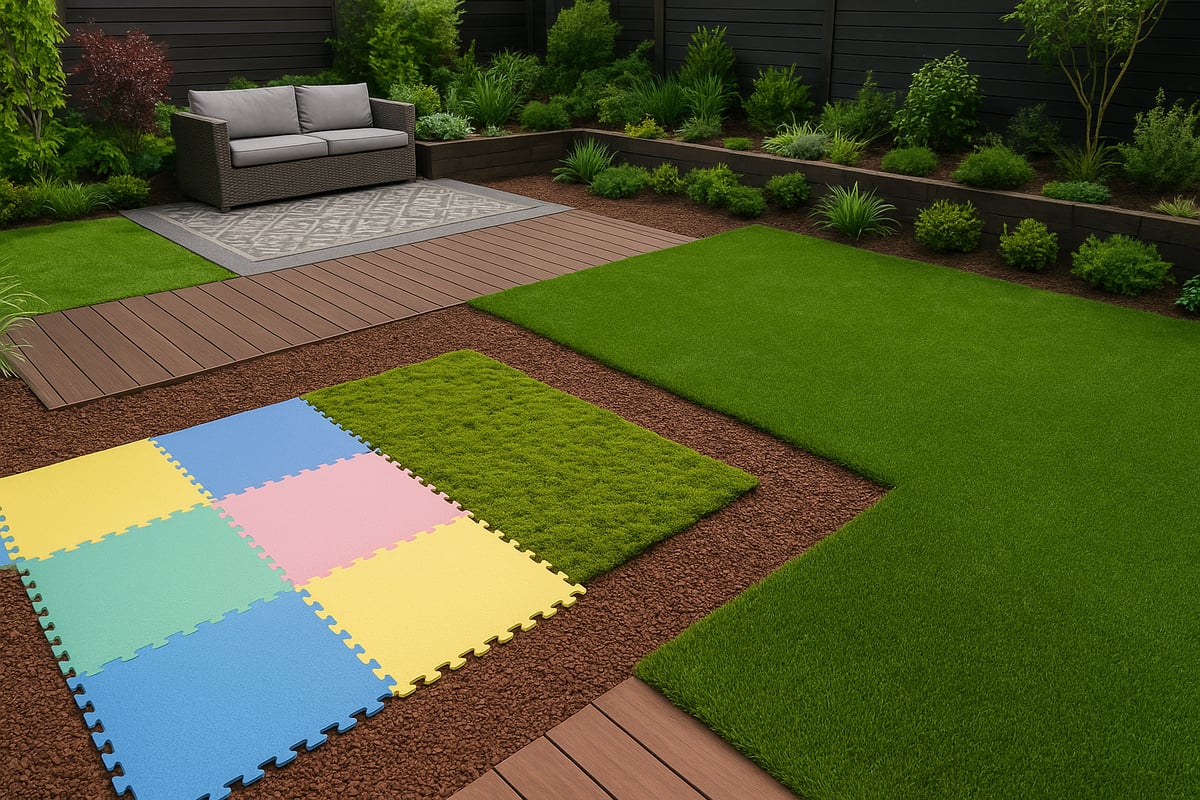
1. [Artificial Grass & Turf]
Artificial grass remains a top choice for soft garden flooring in 2025. It offers a lush, green appearance throughout the year, eliminating the need for mowing or watering. The surface is soft and cushioned underfoot, making it safe for children and pets to play. UV-resistant fibers ensure that the vibrant color will not fade, even with prolonged sun exposure.
A key benefit of artificial turf is its built-in drainage, which prevents puddles after rain. This makes it ideal for low-maintenance lawns, play spaces, and pet runs. When planning installation, focus on proper base preparation and select the right infill to enhance durability and comfort.
The cost of artificial turf typically ranges from $8 to $15 per square foot installed. While the initial investment is higher than some alternatives, the long-term savings on maintenance and water make it a cost-effective option. Hypoallergenic properties and eco-friendly variants are available, supporting healthier, greener living.
For those seeking more details on advanced turf solutions and installation advice, Artificial Turf Flooring Solutions provides in-depth guidance. The main drawbacks are the upfront cost and the tendency for the surface to get warm in direct sunlight. Still, artificial grass is a versatile and reliable soft garden flooring option for modern outdoor spaces.
2. [Rubber Mulch Flooring]
Rubber mulch is made from recycled tires, offering an eco-friendly and shock-absorbent solution for soft garden flooring. It excels in play areas, pathways, and beneath swings, where safety is a top priority. Unlike organic mulch, rubber mulch will not decompose or attract pests, making it a low-maintenance choice.
Available in a variety of colors and textures, rubber mulch flooring can complement any garden design. Installation involves laying a weed barrier and spreading the mulch evenly to create a uniform surface. The cost typically falls between $6 and $12 per square foot, providing a balance between affordability and durability.
Rubber mulch is known for its resilience, requiring minimal upkeep over time. It is durable and safe, reducing the risk of slips and injuries. However, it can scatter with heavy use and may emit a mild rubber odor initially, which usually dissipates after installation.
This soft garden flooring option is particularly valued for its environmental benefits, as it reuses materials that would otherwise occupy landfills. It is ideal for families, playgrounds, and anyone looking to enhance safety and sustainability in their outdoor spaces.
3. [Outdoor Foam Tiles]
Outdoor foam tiles bring versatility and comfort to any garden. Made from interlocking EVA foam, these tiles are designed for quick, DIY-friendly installation. They create a soft, cushioned surface ideal for play zones, yoga spaces, or shaded relaxation corners. Water-resistant properties make them easy to clean and maintain.
The tiles come in a wide array of colors and patterns, allowing you to personalize your garden aesthetic. Thanks to their snap-together design, foam tiles are portable and can be rearranged as needed. This flexibility makes them suitable for renters or those who frequently update their outdoor décor.
Installation is straightforward, requiring no adhesives or special tools. The cost ranges from $3 to $7 per square foot, making them one of the most affordable soft garden flooring choices. Lightweight and removable, foam tiles are also easy to replace if damaged.
Despite their benefits, foam tiles are not recommended for areas with heavy furniture, as they may compress or tear under weight. Some colors may fade with prolonged sun exposure. Still, for families seeking a practical, soft garden flooring solution, outdoor foam tiles deliver comfort and convenience.
4. [Wood Composite Deck Tiles]
Wood composite deck tiles blend recycled wood fibers with plastic to create a natural-looking yet soft garden flooring option. These tiles are slip-resistant, splinter-free, and provide a comfortable walking surface, making them ideal for patios and balconies. Their modular, click-in design ensures easy installation without the need for professional help.
Composite deck tiles require little maintenance, as they do not need staining or sanding. They are available in a range of colors and finishes, allowing you to create a stylish, contemporary outdoor area. The typical cost ranges from $8 to $12 per square foot.
Durability is a key advantage, with these tiles resisting moisture, fading, and insect damage. They are also eco-friendly, utilizing recycled materials that reduce environmental impact. However, in direct sunlight, the surface can become hot, so consider using rugs or shade in exposed areas.
Some installations may require edging to keep the tiles secure. Overall, wood composite deck tiles are a reliable, attractive choice for soft garden flooring, supporting both sustainability and modern design needs.
5. [Cork Outdoor Flooring]
Cork outdoor flooring offers a naturally soft and resilient underfoot feel, making it an excellent soft garden flooring choice for relaxation spaces. As a sustainable and biodegradable material, cork appeals to environmentally conscious homeowners. It is resistant to mold, mildew, and pests, ensuring a healthy outdoor environment.
The warm, earthy appearance of cork suits garden retreats and meditation zones. Installation requires waterproofing and sealing to protect against moisture, which helps maintain longevity. The cost ranges from $7 to $13 per square foot, reflecting its premium, eco-friendly status.
Cork provides excellent insulation, keeping surfaces warm in cooler weather and comfortable for barefoot use. Regular sealing is necessary to preserve its appearance and durability. Color options are somewhat limited, but the natural look integrates beautifully with plantings and wooden accents.
If you seek a unique, sustainable soft garden flooring solution, cork delivers comfort, style, and environmental benefits. Its gentle surface is perfect for those who prioritize both wellness and aesthetics in their outdoor spaces.
6. [Outdoor Carpet & Rugs]
Outdoor carpet and rugs add instant color, pattern, and softness to patios and decks. Constructed from weather-resistant polypropylene or olefin fibers, these products are designed to withstand outdoor conditions while enhancing comfort. They are easy to install, move, and clean, making them a flexible option for soft garden flooring.
UV and mildew resistance ensure longevity, even in exposed areas. Outdoor rugs are available in various sizes, shapes, and designs, allowing you to refresh your garden’s look with minimal effort. Costs range from $2 to $8 per square foot, offering an affordable way to elevate outdoor spaces.
Anchoring may be needed to prevent movement in windy conditions. The lifespan of outdoor carpets depends on exposure and care. Regular cleaning helps maintain their appearance and functionality.
This soft garden flooring idea is perfect for renters, seasonal updates, or anyone wanting to create a cozy, inviting outdoor atmosphere. With so many design options, outdoor rugs are a simple yet impactful way to enhance your garden’s comfort and style.
7. [Playground Safety Surfacing]
Playground safety surfacing is engineered for maximum shock absorption, making it the safest soft garden flooring for families with young children. These surfaces, made from rubber or foam mats, meet rigorous ASTM safety standards for fall protection.
Ideal for home playgrounds, under climbing frames, and beneath swings, this flooring comes in bright colors and custom shapes to suit various themes. The cost is higher, typically $10 to $20 per square foot, reflecting its specialized safety features.
Durability and weather resistance are notable strengths, ensuring the surface remains effective in all seasons. Installation is often best handled by professionals, especially for larger or more complex play zones.
While the upfront investment is significant, the peace of mind and long-term safety benefits are invaluable. Playground safety surfacing is the ultimate soft garden flooring solution for active families who prioritize well-being and fun.
8. [Living Moss & Groundcover Mats]
Living moss and groundcover mats deliver a truly organic approach to soft garden flooring. These living surfaces are cool to the touch and visually striking, creating a unique, eco-friendly garden feature. Moss mats support biodiversity and attract pollinators, enhancing your garden’s environmental value.
Installation involves rolling out mats or planting plugs in partially shaded, moist areas. The cost ranges from $5 to $15 per square foot, depending on the species and coverage desired. Regular watering is essential, as moss thrives in damp conditions.
This soft garden flooring option stands out for its sustainability and ability to support wildlife. However, it is not suitable for full sun and requires consistent care to maintain its lush appearance.
For gardeners seeking a distinctive, nature-inspired flooring, moss and groundcover mats are a rewarding choice. They bring tranquility and life to shaded corners and garden retreats.
9. [Pea Gravel with Geotextile Base]
Pea gravel combined with a geotextile base creates a soft, walkable surface that is both affordable and natural. Rounded, small stones are comfortable underfoot and stay cool, making them ideal for informal paths, seating areas, or around fire pits.
The geotextile fabric beneath prevents weeds and minimizes the risk of stones sinking into the soil. Installation is straightforward and cost-effective, typically $3 to $6 per square foot. Pea gravel drains well, helping to keep the garden dry and accessible.
While this soft garden flooring can shift underfoot, edging helps contain the stones and maintain tidy borders. Occasional raking or topping up is required for upkeep.
Pea gravel offers a relaxed, timeless look that blends seamlessly with plantings and hardscapes. For those seeking a budget-friendly, low-maintenance soft garden flooring option, pea gravel with geotextile base is an excellent solution.
How to Select the Right Soft Garden Flooring for Your Space
Finding the perfect soft garden flooring can transform your outdoor area into a comfortable, stylish, and practical haven. To make the best choice, assess your space, personal needs, and long-term goals. Here is a step-by-step approach to guide your selection process.
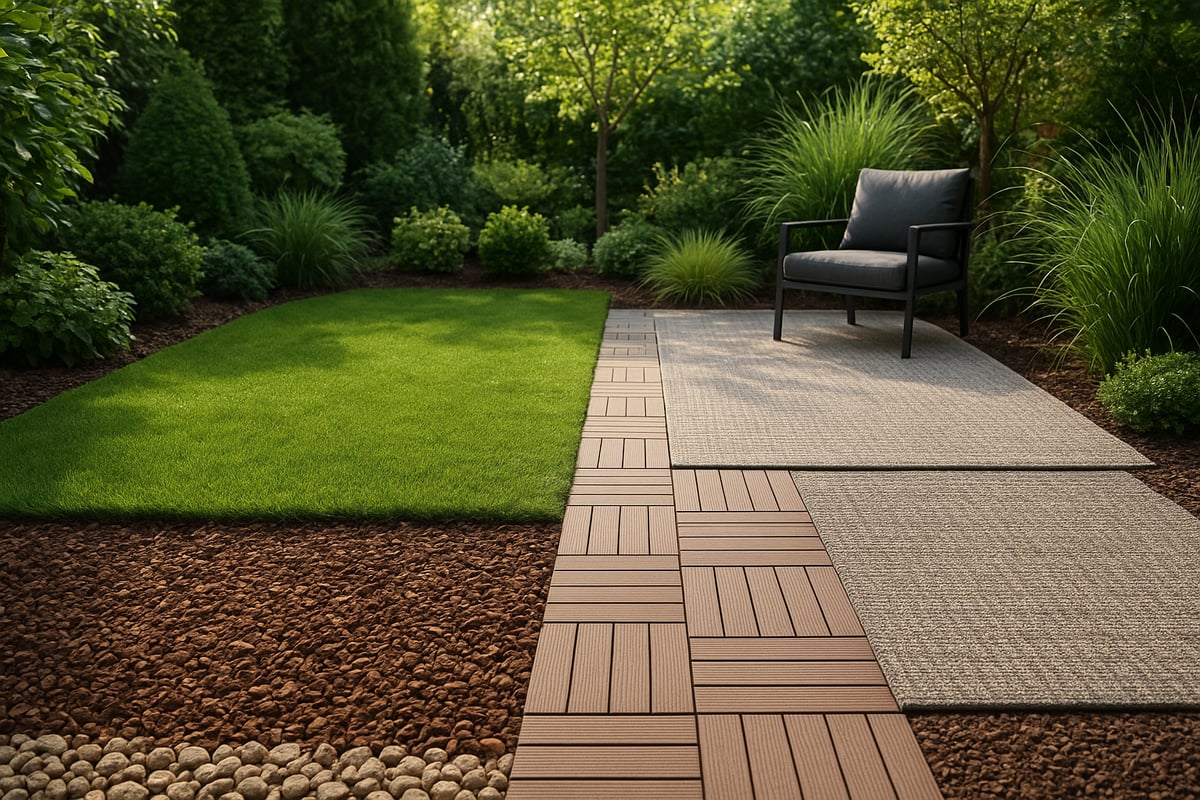
Assessing Your Garden’s Needs
Start by evaluating how your outdoor space will be used. Will it serve as a play area for children, a pet-friendly zone, or a relaxing retreat for adults? The answer will influence your soft garden flooring selection. High-traffic areas need durable, shock-absorbent surfaces, while quiet corners may benefit from plush, cozy materials.
Consider the following:
- Primary users (children, pets, adults)
- Activities (play, dining, lounging)
- Size and shape of the space
Matching the flooring type to your needs ensures optimal safety, comfort, and satisfaction.
Budgeting and Long-Term Value
Balancing upfront investment with future savings is crucial when choosing soft garden flooring. Some options may cost more initially but offer lower maintenance and longer lifespans. For affordable ideas and inspiration, explore Cheap Garden Floor Ideas for solutions that combine value and quality.
Compare costs by considering:
- Installation expenses
- Maintenance frequency
- Expected lifespan
Investing wisely now can provide significant savings and enjoyment in the years ahead.
Aesthetic Goals and Design Integration
Your garden should reflect your personal style. Soft garden flooring comes in a variety of colors, textures, and patterns to complement modern, rustic, or playful themes. Think about how each material’s look and feel will enhance your overall design.
Ways to integrate flooring with your garden:
- Coordinate colors with plants and furniture
- Mix materials for visual interest
- Choose patterns that echo your home’s architecture
A cohesive design elevates your outdoor experience.
Sustainability and Environmental Impact
Eco-conscious homeowners are increasingly prioritizing sustainable soft garden flooring. Many products use recycled or renewable materials, which reduces environmental impact. Cork, recycled rubber, and biodegradable options are excellent choices for green gardens.
Key considerations include:
- Source of materials
- Manufacturing processes
- End-of-life recyclability
Opting for sustainable flooring supports a healthier planet and garden.
Installation and DIY vs. Professional Help
Some soft garden flooring types are simple to install, making them ideal for DIY enthusiasts. Modular tiles and foam mats snap together easily, while living moss or intricate patterns may require professional expertise.
Assess your skills and resources:
- DIY-friendly: foam tiles, composite deck tiles, rugs
- Professional help: living groundcovers, complex layouts
Choosing the right installation method ensures a smooth, lasting result.
Local Climate and Weather Resistance
Climate should play a key role in your soft garden flooring decision. Select UV-resistant, water-draining, and frost-proof options for durability in your region. For example, composite tiles perform well in cold climates, while artificial turf excels in dry, sunny areas.
Checklist for weather compatibility:
- UV stability
- Drainage capabilities
- Resistance to mold and mildew
Proper selection prevents premature wear and costly repairs.
Maintenance and Cleaning Requirements
Maintenance varies widely among soft garden flooring types. Some need only occasional sweeping, while others require regular sealing or watering. Factor in cleaning convenience and repair ease when making your decision.
Maintenance tips:
- Choose stain-resistant materials for dining areas
- Opt for modular designs for easy section replacement
- Store removable items during harsh weather
Prioritizing low-maintenance options lets you spend more time enjoying your garden.
Installation and Maintenance Tips for Soft Garden Flooring
Proper installation and maintenance are essential for getting the most from your soft garden flooring. With the right preparation, you can enjoy a comfortable, long-lasting surface that enhances your outdoor space and supports your lifestyle.
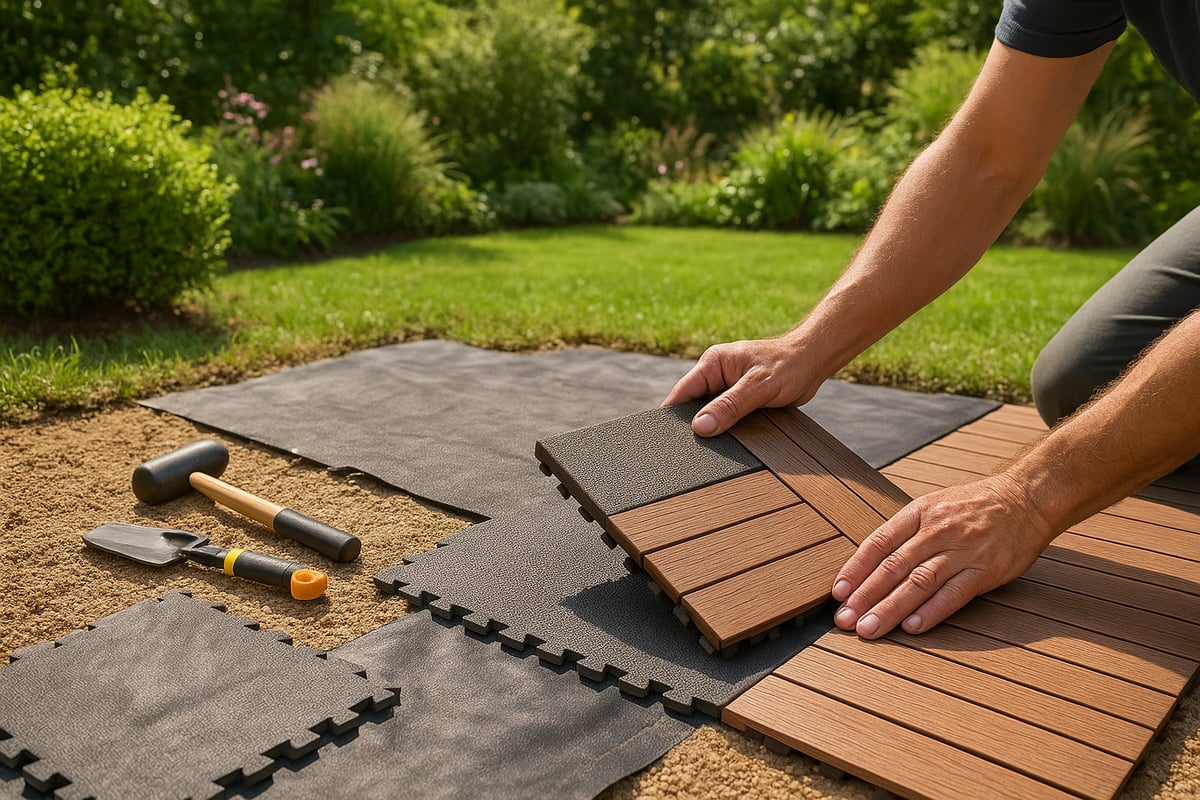
Site Preparation and Planning
Begin by clearing the area of plants, rocks, and debris. Level the ground to prevent uneven surfaces and ensure stability for your soft garden flooring. Install a weed barrier to minimize future growth and moisture issues.
Measure your space precisely. This step helps reduce waste and ensures your selected flooring fits perfectly. Planning ahead saves you time and effort during installation.
Preparation Checklist Table
| Step | Purpose |
|---|---|
| Clear Area | Remove obstacles |
| Level Ground | Prevent tripping and sinking |
| Weed Barrier | Reduce maintenance |
| Measure Space | Ensure proper fit |
Professional vs. DIY Installation
Some soft garden flooring products are designed for easy DIY installation. Options like interlocking foam tiles or composite deck tiles allow homeowners to create a finished look with minimal tools. For example, Composite Deck Tiles for Outdoors are user-friendly and require no adhesives.
However, larger or more complex projects, such as installing living moss mats, may benefit from professional expertise. Assess your skills, timeline, and budget before deciding.
Seasonal Care and Upkeep
Regular maintenance helps your soft garden flooring last longer. Sweep or hose down surfaces to remove leaves and dirt. For living materials, monitor moisture and sunlight to keep them healthy.
Check for wear and address issues promptly. Seasonal care is especially important for surfaces exposed to harsh weather. This routine keeps your soft garden flooring looking its best.
Repair and Replacement
Modular flooring options make repairs simple. If a tile or mat becomes damaged, you can easily swap it out for a new one without disturbing the rest of the surface.
Keep a few spare pieces on hand for quick fixes. This approach minimizes downtime and ensures your space stays safe and attractive.
Maximizing Longevity
To extend the lifespan of your soft garden flooring, use recommended underlayments and protective coatings. Store removable items indoors during extreme weather.
Follow manufacturer guidelines for cleaning and sealing. With consistent care, your flooring can remain comfortable and vibrant for years, supporting every activity in your garden.
Trends and Innovations in Soft Garden Flooring for 2025
Staying ahead of the curve in garden design means embracing the latest trends in soft garden flooring. For 2025, innovation centers on eco-conscious materials, smart features, and enhanced comfort. Let us explore the top developments shaping outdoor spaces this year.
Eco-Friendly Materials and Manufacturing
Sustainability is at the forefront of soft garden flooring evolution. Manufacturers are prioritizing recycled content, such as rubber from used tires and plant-based composites. Biodegradable options like cork and low-VOC finishes help reduce environmental impact. According to Top 7 Flooring Trends That Will Take Over 2025, homeowners are seeking green solutions that look beautiful and align with their values.
- Recycled rubber and cork tiles
- Plant-based and biodegradable materials
- Low-emission manufacturing
These options not only benefit the planet but also offer long-term durability and style for any garden.
Smart and Modular Flooring Systems
Modular designs are revolutionizing soft garden flooring. Click-together tiles, interlocking foam, and integrated drainage systems make installation simple and flexible. Homeowners can now personalize layouts and adapt their outdoor flooring as needs change. Smart features, such as sensor-activated lighting or water management, are making their way into contemporary gardens. For a deeper dive into such innovations, see Flooring Trends 2025: What’s New Underfoot.
- Click-together and interlocking tiles
- Built-in drainage for weather resistance
- Technology-enhanced surfaces
These advancements ensure soft garden flooring remains practical, stylish, and forward-thinking.
Multi-Functional and Hybrid Surfaces
Blending different materials is a major trend in soft garden flooring for 2025. Homeowners are creating zones by combining soft flooring with hardscapes like stepping stones or gravel. This approach enhances accessibility, safety, and visual appeal. Hybrid surfaces can transition from play areas to dining spaces seamlessly, making gardens more versatile.
- Artificial turf with stone borders
- Rubber mulch pathways alongside pavers
- Foam tiles integrated with wood decks
Multi-functional layouts maximize space and adaptability in modern outdoor living.
Customization and Personalization
Personal expression is key in garden design. Soft garden flooring now comes in custom colors, patterns, and even branded options. Bespoke flooring allows homeowners to match their outdoor spaces with their personalities or themes. Unique designs make gardens stand out while providing a comfortable, inviting atmosphere.
- Custom colorways and patterns
- Branded or themed flooring
- Mix-and-match modular pieces
With these choices, every garden can be truly one-of-a-kind.
Wellness and Sensory Design
Wellness drives many choices in soft garden flooring. Surfaces that are soft underfoot, hypoallergenic, and gentle for barefoot use are increasingly popular. Materials that reduce allergens and absorb sound create tranquil, relaxing environments. Homeowners are prioritizing comfort and health, turning gardens into true retreats.
- Cushioned, barefoot-friendly materials
- Allergen-reducing surfaces
- Noise-absorbing flooring
Prioritizing wellness ensures that gardens nurture both body and mind.
Climate-Adaptive Solutions
Climate resilience is vital for soft garden flooring longevity. In 2025, new flooring materials are engineered to resist heat, drain water efficiently, and withstand frost. These features are especially important for urban and rooftop gardens exposed to extreme weather. Adaptable flooring extends the life and beauty of outdoor spaces.
- UV-resistant surfaces for sunny climates
- Advanced drainage for rainy regions
- Frost-proof materials for cold environments
Selecting climate-adaptive solutions helps maintain comfort and performance all year round.

